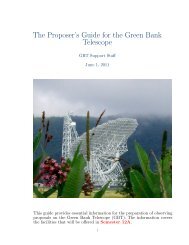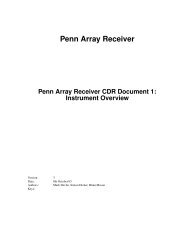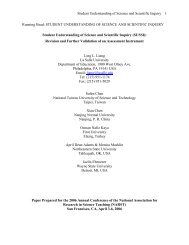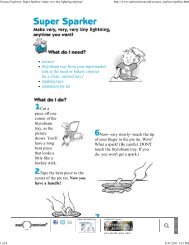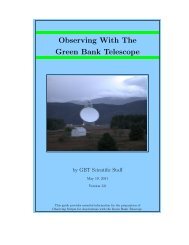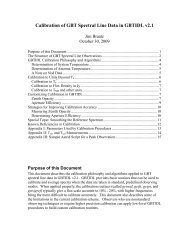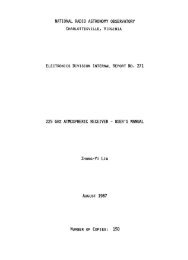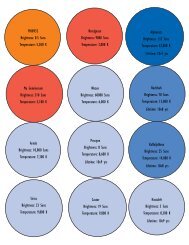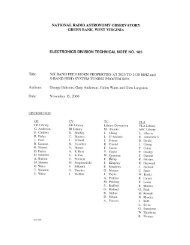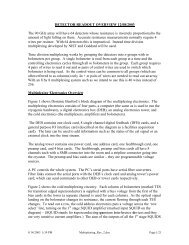205 - National Radio Astronomy Observatory Green Bank
205 - National Radio Astronomy Observatory Green Bank
205 - National Radio Astronomy Observatory Green Bank
Create successful ePaper yourself
Turn your PDF publications into a flip-book with our unique Google optimized e-Paper software.
<strong>National</strong> <strong>Radio</strong> <strong>Astronomy</strong> <strong>Observatory</strong><br />
EDTN <strong>205</strong><br />
Cryogenic (4K) Measurements of Some Resistors and Capacitors<br />
A. R. Kerr and M. Lambeth<br />
5 March 2007<br />
Abstract: This note describes measurements of some chip capacitors and thin-film resistors<br />
at 4.2 K. The capacitors have the following dielectrics: SiO 2 , ATC types CA and CC, and ATC<br />
type 700A. The resistors are TaN and nichrome thin film made by Mini-Systems, Inc.<br />
Resistors and capacitors specified for operation in the standard military temperature range<br />
(&55EC to +125EC) may have substantially different characteristics at cryogenic temperatures<br />
(~ &270EC). For many years it has been known that resistors and attenuators using nichrome thin<br />
films could be used in cryogenic systems. However, TaN has largely replaced nichrome for use in<br />
commercial resistive thin-film microwave components. About 1980, we found that TaN resistors<br />
from one manufacturer changed substantially at ~ 4 K – this did not seem surprising given that Ta<br />
and TaN are listed as superconductors with critical temperatures in the range 4.4 – 14 K [1]. In<br />
recent years, NRAO has successfully used TaN resistors in many cryogenic applications at<br />
temperatures between 4 K and 15 K. Apparently, the suitability of TaN components for cryogenic<br />
operation depends on the particular process used to fabricate the films.<br />
The Mini-Systems MSMT series of RC networks [2] uses TaN thin-film resistors and parallelplate<br />
capacitors with a SiO 2 dielectric. They rely on the conductivity of the silicon substrate to<br />
connect the lower plates of capacitors to the ground metalization on the backside of the substrate.<br />
We were concerned that carrier freeze-out at ~ 4 K might effectively disconnect the capacitors from<br />
ground.<br />
The Mini-Systems WATF series of chip resistors [3] are available with TaN or nichrome thin<br />
films and different substrate materials. The one tested here has a nichrome film on an alumina<br />
substrate.<br />
Past experience at NRAO has indicated that porcelain and ceramic multi-layer chip capacitors<br />
[4], and ATC 111 single-layer capacitors [5] with dielectric types A (K = 14), BB (K = 31), or CA<br />
(K = 60), do not change substantially between room temperature and ~ 12 K, and amplifiers<br />
employing these capacitors have operated well at 4.2 K. It was not known whether capacitors with<br />
dielectric type CC (K = 130) would be useable at ~ 4 K.<br />
The measurements described here were made on the following components:<br />
Capacitors:<br />
! ATC 700A160JCA150X – 16 pF porcelain and ceramic multi-layer chip capacitor.<br />
! ATC 111UCA3R9C100TT – 3.9 pF single-layer capacitor with type CA dielectric.<br />
! ATC 111UCC3R9C100TT – 3.9 pF single-layer capacitor with type CC dielectric.<br />
! Mini-Systems MSMT 210-0418 – 16 pF parallel-plate capacitor with SiO 2 dielectric.<br />
! NRAO lead transition – a quartz standoff chip allowing connection of a heavy wire,<br />
attached by solder, to a thin bond wire.
Resistors:<br />
! Mini-Systems MSMT 210-0418 – 5 ohm TaN resistor.<br />
! Mini-Systems MSMT 210-0418 – 50 hm TaN resistor.<br />
! Mini-Systems MSMT 210-0418 – 1000 ohm TaN resistor.<br />
! Mini-Systems WATF 7AN50R00J-HWU – 50 ohm nichrome resistor.<br />
Capacitor Measurements<br />
The capacitor to be measured was mounted on a metal ground plane with Epotek H20E<br />
conductive epoxy and connected to the center conductor of an SMA connector via a short gold bondwire.<br />
This fixture was connected through a 4-foot length of stainless steel 50-ohm coaxial cable to<br />
a 1 kHz digital capacitance meter [6]. With the capacitor disconnected, the capacitance of the cable<br />
and fixture was measured at room temperature and with the fixture immersed in liquid helium (4.2<br />
K). The measurements were repeated with the capacitor connected, and its capacitance determined<br />
as the difference between the reading and the open-circuit capacitance.<br />
In AC bridge measurements using a long cable between the bridge and the unknown, the<br />
electrical length of the cable can introduce an apparent capacitance offset in addition to the static<br />
capacitance of the cable. In the present measurements it was shown by measuring the same<br />
capacitor at room temperature with and without the cable that the length of cable had no significant<br />
effect on the results. The absolute accuracy of the capacitance meter, as given by its manufacturer<br />
for the range used, is ± (1 % of reading + 0.2 pF), which is ± 0.36 pF or 2 % for a 16 pF capacitor.<br />
The repeatability is ± 0.1 pF.<br />
Capacitor<br />
Nominal value / Dielectric<br />
Room temp<br />
pF<br />
4 K<br />
pF<br />
Increase<br />
on cooling<br />
ATC 700A160JCA150X<br />
16 pF ± 5 % / porcelain & ceramic<br />
4 x ATC 111UCA3R9C100TT<br />
4 x (3.9 pF ± 0.25 pF) / CA<br />
4 x ATC 111UCC3R9C100TT<br />
4 x (3.9 pF ± 0.25 pF) / CC<br />
16.9 17.1 +0.2 ± 0.2 pF<br />
16.0 15.1 &0.9 ± 0.2 pF<br />
15.8 19.1 +3.3 ± 0.2 pF<br />
Mini-Systems MSMT 210-0418<br />
16 pf ± 5 % / SiO 2<br />
16.6 16.7 +0.1 ± 0.2 pF<br />
NRAO lead transition<br />
– / SiO 2<br />
1.2 1.4 +0.2 ± 0.2 pF<br />
-2-
Resistor Measurements<br />
The 5-ohm and 50-ohm resistors were measured using a 4-wire ohm-meter [7]. The 1000-ohm<br />
resistor was measured with a two-wire configuration, corrected for lead resistance, using the same<br />
instrument. The results are shown in the table. The accuracy of the 4-wire ohm-meter given by its<br />
manufacturer for the range used is ± (0.01 % of reading + 0.01 ohm), which corresponds to ± 0.015<br />
ohm for a 50-ohm resistor and ± 0.01 ohm for a 5-ohm resistor. Mini-Systems' tolerance on the<br />
resistor values is 1 %.<br />
Mini-Systems TaN and Nichrome Resistors<br />
Resistor Type Room temp.<br />
ohms<br />
4 K<br />
ohms<br />
% increase<br />
on cooling<br />
5 ohm 1 % TaN 4.95 4.98 0.6 %<br />
50 ohm 1 % TaN 50.08 51.54 2.9 %<br />
50 ohm 5 % Nichrome 49.52 49.69 0.3 %<br />
1000 ohm 1 % TaN 999 1029 3.0 %<br />
Discussion & Conclusions<br />
Capacitors: The ATC 700 porcelain and ceramic capacitor, and the two quartz capacitors exhibited<br />
no change on cooling to 4 K, within the measurement error. The ATC 111 CA capacitor decreased<br />
in value by 6 %, and the ATC 111 CC capacitor increased by 21 %.<br />
Concern that, for the Mini-Systems MSMT RC network, carrier freeze-out might isolate the<br />
capacitors from ground turned out to be unfounded. These capacitors exhibited no measurable<br />
change between room temperature and 4 K. The absence of carrier freeze-out in the silicon substrate<br />
is explained by the fact that in heavily doped Si the impurity ionization energy vanishes and the<br />
carrier density is independent of temperature [8]. The MSMT chips use boron doped 111-oriented<br />
silicon with resistivity 0.001-0.005 ohm-cm, which corresponds to a doping density > 10 19 cm -3 .<br />
Resistors: Consistent with past experience with nichrome thin-film resistors, the resistance of the<br />
50-ohm nichrome resistor increased only 0.3 % on cooling to 4.2 K. The TaN resistors increased<br />
on cooling from room temperature to 4.2 K as indicated in the table – less than 1 % for the 5-ohm<br />
resistor, and ~ 3 % for the 50- and 1000-ohm resistors. This indicates that these TaN resistors do<br />
not undergo a superconducting transition at or above 4.2 K. Given our past experience, and the fact<br />
-3-
that TaN is listed as a superconducting compound [1], it would seem wise to test TaN resistors<br />
destined for cryogenic operation to verify that there is no unacceptable change on cooling.<br />
Acknowledgment<br />
Thanks to Robert Lamarre of Mini-Systems, Inc., for providing technical information about the<br />
MSMT 210-0418 RC networks.<br />
References<br />
[1] American Institute of Physics Handbook, Third Ed., pp. 9-130 to 9-141, McGraw-Hill, 1972.<br />
[2] http://www.mini-systemsinc.com/msithin/Thin_%20Film_%20Catalog.pdf<br />
[3] http://www.mini-systemsinc.com/msithin/Thin_%20Film_%20Catalog.pdf<br />
[4] http://www.atceramics.com/products/multilayer_capacitors.asp<br />
[5] http://www.atceramics.com/products/dielectric_specifications.asp<br />
[6] GW Instruments digital LCR meter model LCR-814.<br />
[7] HP digital multimeter model 34401A.<br />
[8] P. W. Chapman, O. N. Tufte, J. D. Zooke, and D. Long, "Electrical Properties of Heavily Doped<br />
Silicon," J. Appl. Phys., vol. 34, no. 11, pp. 3291-3295, Nov. 1963.<br />
-4-



